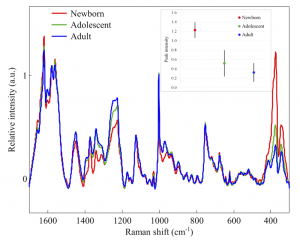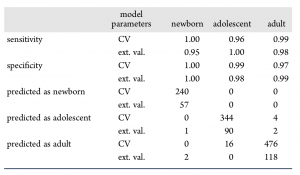Title: Differentiating Donor Age Groups Based on Raman Spectroscopy of Bloodstains for Forensic Purposes
Authors: K. C. Doty, I. K. Lednev
Year: 2018
Journal: ACS Central Science
https://pubs.acs.org/doi/10.1021/acschembio.8b00171
Have you ever watched a criminal drama on TV? Each episode seems to contain one unavoidable trope: the detectives stand around twiddling their thumbs as they wait for a piece of crucial evidence to arrive at the last possible minute, delivered by the overbooked and overworked forensics team. How differently would these situations play out if narrowing down a suspect list was a simple as testing a blood sample on-site?
The authors of this paper are actively working to overthrow the last-minute forensics trope through the use of Raman spectroscopy, a technique that can distinguish chemical structures based on unique scattering patterns of monochromatic light. Previous research by this lab has shown that scientists can develop Raman-based tests to rapidly and accurately classify bodily fluid samples based upon race and sex. These classifications are based upon small differences in the composition of lipids and proteins in blood samples collected from different groups of people.
Although both race and sex can be accurately determined from DNA analysis of a blood sample, this process can be time-consuming and labor-intensive compared to a quick spectroscopic read. Current forensic DNA analysis methods are also limited because they do not provide an age classification for a sample donor. In this paper, the researchers sought to expand their Raman spectroscopy tool kit by developing a method to sort samples into age categories based upon several key peak shifts.
The authors began by collecting samples from a subject pool with three groups chronological age (CA) groups: newborns with a CA of less than 1 year, adolescents with a CA of 11-13 years, and adults with a CA of 43-68 years. Raman spectroscopy analysis for all of the subjects was compiled into a single graphic to identify diagnostic peaks for age determination (Figure 1, below).

Figure 1: Raman spectrum comparison for newborn, adolescent, and adult blood samples. Two major peak differences were identified near 375 cm-1 and 1210-1270 cm-1.
Based upon these data, a model was constructed to sort external sample data into one of the three CA categories (newborn, adolescent, or adult). The sensitivity (true positive rate) and specificity (true negative rate) of the model were analyzed to determine how well it performed during validation testing (Table 1, below). External validation was measured by feeding in spectrum from the same original subjects while cross-validation was determined using new, outside data (data not used to generate the model).
Table 1: Cross-validated (CV) and external validation (ext. val.) SVMDA prediction results for distinguishing between donors from the three age groups.

Based upon the authors’ findings, it seems that blood-based spectroscopic analysis may provide a fast and easy method for sorting a sample into a broad age category. However, the SVMDA model shown here is still in its preliminary design; despite providing a range of CAs, the initial subject samples were mainly limited to a single race and gender. The authors hope to expand their model to capture a more diverse subject population and provide increased accuracy in their identification protocol.
Additionally, the spectroscopic changes shown in this paper were relatively minor and limited to very broad age groups. Hopefully the researchers will be able to further improve the sensitivity of this technique to distinguish subjects with lower differences in CA. This would be an exciting development for forensic analytical chemistry – with a portable Raman spectrophotometer, one might someday be able to identify a suspect with a single swipe at the scene of the crime!

